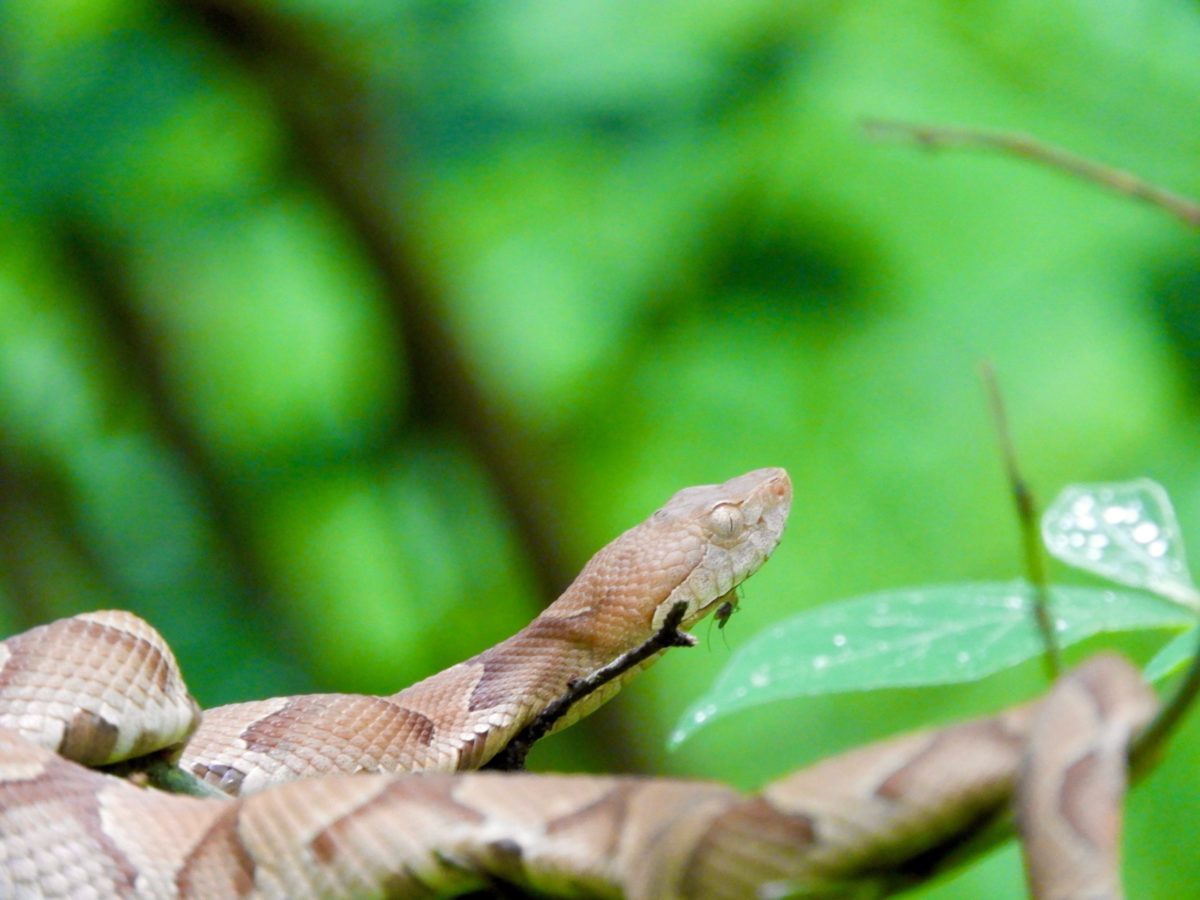Sharing the World with Snakes


Be a Snake “Charmer,” not a Snake Harmer
How I Survived a Copperhead Snakebite
By Kendell Loyd
In late May, while doing scientific research on bird populations near Branson, MO, I was bitten by a copperhead. I was walking along a well-beaten footpath where I had walked countless times. I stopped to clear a few plants and had been standing in the same place for over a minute when I shifted a bit and felt a stinging on my left foot. I looked around for the wasp I had disturbed but saw nothing flying. I looked down at my foot in my Chaco sandal, expecting to see the mark of a wasp sting, but instead, a tiny drop of blood had formed on my second little toe. My confusion changed to slight panic as I noticed the orange and brown patterned snake coiled under some leaves.
The Eastern Copperhead (Agkistrodon contortrix) is the most common venomous snake in Missouri. They are timid, preferring to stay hidden and hopefully unnoticed, relying on their leaf-pattern camouflage for protection. They prefer rocky areas and forest edges and hunt almost exclusively small rodents.
Missouri is home to five species of snakes considered potentially dangerous to humans due to their venom: Eastern Copperhead, Northern Cottonmouth, Massasauga Rattlesnake, Pygmy Rattlesnake, and Timber Rattlesnake. Despite this fear-evoking label of “venomous”, there have only been five reported deaths attributed to snake bites in Missouri, while lightning (47 cases) and dogs (32 cases) have killed many more. In most, if not all, the instances where death resulted, other underlying medical conditions also existed.
All five species of snake belong to the subfamily Crotalinae, a group of about 150 snake species commonly referred to as pit vipers. This taxonomic group is distinguished by the presence of a heat-sensing organ located between the snake’s eye and nostril. This organ is especially valuable for the snake as it allows them to more easily detect both prey and potential predators, as well as allowing for nocturnal hunting. The genus Agkistrodon, to which the copperhead and cottonmouth belong, roughly translates as fishhook-tooth, referring to the shape of the fangs.
It is important to note that snakes are venomous, not poisonous. Venoms and poisons differ mainly in their use and form of delivery. Poisonous organisms often use their toxins for defense, affecting the aggressor through touch, ingestion, or inhalation (e.g. poison ivy). Venomous organisms more often use their toxins for immobilizing or killing prey by injection (e.g. wasps, spiders, and scorpions). Venoms are only dangerous if injected. While a few species of snakes can emit chemicals that cause skin irritation (so, technically poisonous), snakes are almost exclusively venomous.
The venom of snakes in Missouri, including the copperhead that bit me, is mostly hemotoxic, meaning it damages the red blood cells–often interrupting blood clotting and damaging tissue near the injection site. These snakes use their venom, not to kill necessarily, but to immobilize prey, allowing them to easily capture and kill their prey–usually small rodents, fish, or amphibians. Unlike other venomous snakes with venom that attacks the nervous system, hemotoxic venom is slower to react. Often hemotoxic snakes must follow their prey’s scent trail to find the immobilized animal. In humans, the venom is rarely fatal, but complications can arise, and medical attention should always be sought if you suspect a venomous snake has bitten you.
The bite itself had not felt like I had expected. The immediate sting was like a wasp, but my surge of adrenaline almost instantly masked the pain before I was driven to Cox Medical Center in Branson. The snake had bitten me on the second smallest toe of my left foot. The three smallest toes began swelling within minutes, as did the body of my foot. The pain was a dull, pulsing throb. I could feel the blood pressure in my foot increasing as the tissues swelled, constricting blood vessels. As my bloodstream carried the venom, a wave of tingling sensation—that I liken to a leg falling asleep—slowly rose up my calf, through my thigh, and into my hip.
I was admitted into the ER and remained in a private room for 6 hours of observation. My foot was elevated, and the swelling was monitored and marked by writing directly on my leg. The pain increased throughout the day and transformed into a sharp pulsing sting, for which I was given medication. The swelling at its highest extent, went to my lower thigh.
In the following days, I had to stay seated with my foot above my waist or the pain would become unbearable. Two days after the incident, I could readily walk using crutches, and four days after, I could begin putting weight back on the foot.
It has been a week since the snake bite and I can now walk, but I have a limp. My foot and ankle are still swollen, but I can now make out my big toe’s extensor tendon. Certain areas of my calf, foot, and toes are still sensitive to touch. Many of my toes and part of my foot are still a purple-blue from bruising. It will take more time, but the damage will be temporary. I should make a full recovery.
I was not given antivenom for several reasons.
Firstly, Copperheads do not have very potent venom. Overall, they are small snakes that consume small prey, meaning they never need to kill human-sized animals and thus do not possess venom readily strong enough for this.
Amazingly, studies show that snakes can calculate the amount of venom they need to inject: injecting more for larger prey and less for smaller prey. This is beneficial for the snake because the venom is energetically expensive for the snake to make. In a defensive situation, like my snake was in, a small, painful dose typically does the trick, and I received the message loud and clear. In almost all cases of copperhead bites, the body can clear the venom and recover all on its own.
Secondly, antivenom is incredibly expensive, usually costing several thousand dollars per dose, and snakebite cases can require as many as six to eight doses. The price can be attributed to the complicated method of harvesting antibodies from other animals. Due to the pharmaceutical market in the United States and the tiny demand, antivenom can cost 100 times what it costs in other countries.
Lastly, there can be many adverse reactions to antivenom that are impossible to predict. Reactions are typically mild but can be life-threatening, so antivenom is given only when necessary.
Some people asked me if I killed the snake, and I did not. I left the snake where I found it—or where it found me, rather. Snakes invoke fear in many people. They are depicted as evil in many cultural stories, and having no legs makes many people uncomfortable with their appearance. I have heard people say: “The only good snake is a dead snake”, and it is really a shame because snakes can be quite beautiful.
Snakes are an important part of a healthy ecosystem too. They are great predators and play a crucial part in controlling populations of rodents and insects, many of which negatively impact crops and livestock.
In Missouri, all snakes are protected by law and it is illegal to kill a snake that is not directly endangering a person. By that definition, I had the right to kill the copperhead that bit me, but I chose not to. I chose to respect the wildlife in its habitat, and the snake had done nothing wrong by biting me. It was a poor coincidence that our paths crossed, but it was me that intruded into its territory, not the other way around. Despite the pain and discomfort the snake inflicted on me, I was the guest in the forest that day, and unfortunately, I was reminded of it. The animal only acted when it felt that its life was in danger.
When going outside this season, keep in mind that you are stepping into hundreds of organisms’ homes, some of which can cause harm. It is up to you to be proactive, so you do not have to be reactive. Keeping an eye out for snakes and other potentially harmful organisms, doing some basic internet studies on snake identification, and giving the animal its space may help keep you safe and avoid a trip to the hospital. If you see a snake, keep your distance and never make it decide between defending itself and surviving. Never try to pick up snakes. Most snake bites occur because the snake was intentionally provoked. Also, please wear appropriate footwear: a lesson I learned the hard way. The outdoors are wonderful and exciting, but it is up to you to be safe, respect wildlife, and make decisions that benefit yourself and nature.
Figure 1. Eastern copperheads are the most common venomous snake in Missouri. One trait of venomous snakes in Missouri is the cat-like pupil, compared to nonvenomous snakes that have a round pupil.
*This article previously published in the Conservation Federation Magazine here: https://issuu.com/missouriwildlife/docs/july_2020_vol_81_no_4/52



